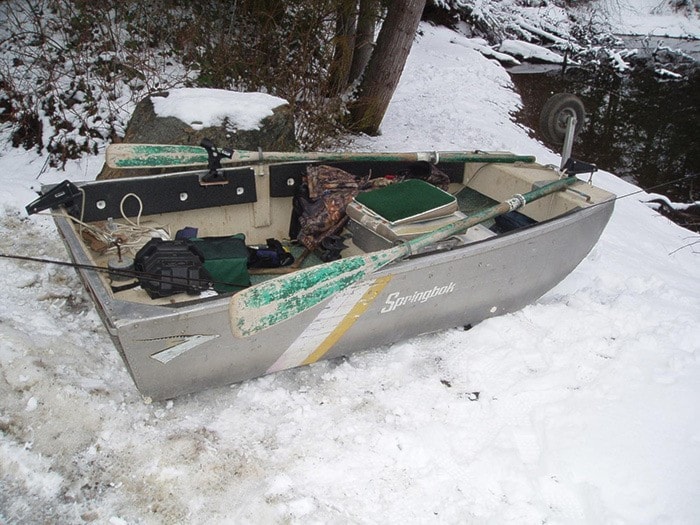The concept of “tipping points” when looking at climate change seems too complex and remote to have much meaning to the pursuits of recreational fishing and hunting in the span of a lifetime. But maybe it is time to take a second look at some of the tipping points going on around us and consider their implications.
Life systems and changes are going on at a continuous rate that has much to do with the ecological changes and physical shifts that make up the natural world. Tipping points can be instantaneous or centuries in making changes in nature.
For example the tipping point for water, from a liquid to a solid (as in ice) is 0 degrees Celsius and from liquid to a gas (as in steam) is 100 degrees Celsius. These tipping points are part of our everyday lives and we seldom think about it.
The photograph with the column shows two stages of water's tipping points in our local situation. The rain has changed to snow and the surface of the lake is about to change from a liquid state to a solid as it freezes.
Nature is full of examples of natural tipping points. If you have fished the Interior lakes of our province you may be aware of the common condition of “winter kill” where the trout in a lake will all be dead in the spring when the ice comes off. They die from a lack of oxygen in the water under the ice that creates a tipping point beyond which they cannot survive.
If you spend much time travelling the northern Interior you will see vast expanses of open land, dead trees or new grasslands that were created by a small bug called a pine beetle where it reached a tipping point in our pine forests so it could grow in numbers and ended up killing millions of square kilometres of pine forest as they ate themselves out of house and home. It is an ongoing climatic tipping point as they eat their way across our northern pine forests. They have a direct influence on our hunting.
If you were growing scallops off Nile Creek you would realize that your scallops have hit a tipping point where they die due to acidification in our marine waters brought on by increased carbon-dioxide dissolved in the water as a result of climate change.
That tipping point took some time before it reached the lethal stage. If you enjoy oysters, this growing tipping point of increased acidification in local waters should be a concern because our oysters may not be able to form shells in the not too distant future.
Over the past few months we have been made aware of the huge mass of warming ocean water that is occupying much of the northeast Pacific Ocean from Oregon to western Alaska. This also includes the western coastlines of British Columbia.
That warm water has implications for Pacific salmon. Salmon are not a species of fish that do well in warm water and it is a threat to their survival. There are also fewer food sources. With regards to the tipping point for our salmon and warm water, it is speculation as to whether or not the condition prevails until our fish seek colder waters in the Arctic and leave the new warm Pacific to tuna and jellyfish.
There is another tipping point for salmon in climate change that leads to warmer summers, lower snowfall and glacier melts – with the result that rivers have low waters that are too warm for salmon to make their annual spawning runs. These multiple tipping points will be sudden as in a single spawning season.
As a prediction for 2015 I see increased numbers of salmon migrating down our cooler inside waters this year.
Ralph Shaw is a master fly fisherman who was awarded the Order of Canada in 1984 for his conservation efforts. In 20 years of writing a column in the Comox Valley Record it has won several awards.
